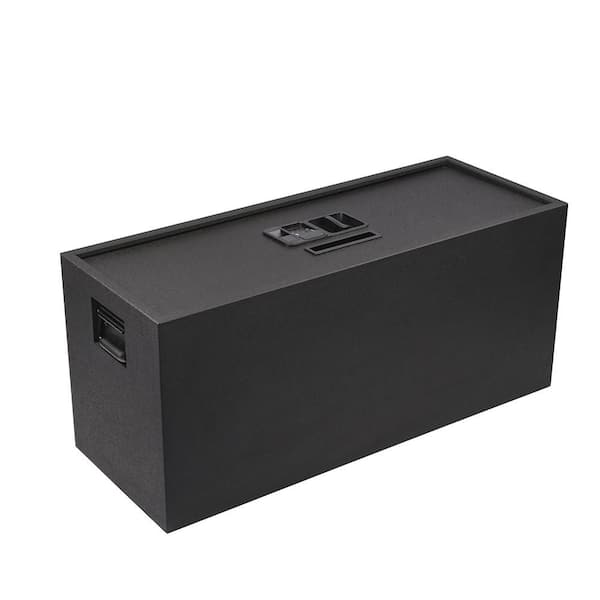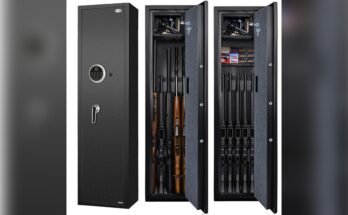Are you worried that wet or dirty fingers might stop your biometric rifle safe from working when you need it most? You’re not alone.
Imagine trying to unlock your safe in a tense moment, only to find your fingerprint won’t register because of moisture or grime. It’s frustrating and could even be dangerous. But how well do these safes really handle less-than-perfect conditions? Keep reading to find out if your biometric rifle safe can be trusted when your fingers aren’t perfectly clean and dry.
This could change the way you protect your firearms.

How Biometric Rifle Safes Operate
Biometric rifle safes use fingerprint technology for secure access. They read and recognize your fingerprint to open the safe. This method is fast and avoids the need for keys or codes.
Understanding how these safes work helps explain their performance with wet or dirty fingers. The technology inside plays a big role in accuracy and ease of use.
Fingerprint Recognition Basics
Fingerprint recognition compares your fingerprint to stored images. The safe scans unique patterns like ridges and valleys on your finger. It matches these details with saved data to confirm your identity.
This process happens quickly, often in less than a second. The system needs a clear print to work well. Smudges or dirt can change the print’s appearance, affecting recognition.
Sensor Technology In Safes
Biometric safes use different sensors to read fingerprints. Optical sensors take a photo of your finger’s surface. Capacitive sensors measure the electric charge from your skin.
Capacitive sensors tend to work better with wet or dirty fingers. They detect details beneath the surface, not just the outer layer. Some safes combine sensor types to improve accuracy.
Advanced safes have software that cleans up the image and ignores minor dirt. This helps reduce access problems caused by moisture or grime on fingers.

Impact Of Wet Fingers On Biometric Sensors
Biometric rifle safes use fingerprint sensors to allow quick access. These sensors read patterns on fingers to verify identity. Wet fingers can affect the sensor’s ability to read these patterns. Understanding how moisture impacts these sensors helps in using the safe effectively.
How Moisture Affects Scanning
Moisture on fingers creates a thin water layer. This layer can block the sensor from capturing clear fingerprint details. The scanner may see a blurry or incomplete pattern. It can cause the safe to deny access even to authorized users. Some sensors work better with slight moisture than others. Still, excess wetness usually causes scanning errors.
Common Issues With Wet Fingerprints
Wet fingerprints often cause failed scans. The sensor may display error messages or require multiple tries. Sometimes, the safe locks temporarily after repeated failures. Dirt combined with moisture worsens the problem. Dirt fills fingerprint ridges, making patterns harder to read. Users must dry and clean fingers for better results. Regular maintenance of the sensor also improves accuracy.
Effect Of Dirty Fingers On Safe Access
Dirty fingers can affect how a biometric rifle safe works. Dirt, oil, or moisture on your fingers can change the way the sensor reads your fingerprint. This may cause delays or errors when trying to open the safe. Understanding these effects helps in choosing and using biometric safes more effectively.
Types Of Dirt And Residue
Fingers often carry different types of dirt. Dust, grease, sweat, and food residue are common. Each type affects the fingerprint scanner in unique ways. Dust and dry dirt can block the sensor’s view. Grease and oil create a slippery surface. Sweat adds moisture that can blur fingerprint details. Food residue can mix with sweat and oil, making the problem worse.
Sensor Response To Contaminants
Biometric sensors detect the ridges and valleys of fingerprints. Dirt and residue can hide these patterns. Some sensors use optical technology that needs a clear view. Others use capacitive sensors that measure electrical signals from the skin. Both types can struggle with dirty fingers. The sensor might fail to recognize the fingerprint or take longer to read it. Cleaning your fingers and the sensor surface can improve access speed and accuracy.
Design Features To Improve Reliability
Biometric rifle safes face challenges with wet or dirty fingers. Moisture and dirt can block sensors or cause errors. Reliable design features help these safes work better in tough conditions. These features improve sensor accuracy and reduce false readings.
Advanced Sensor Materials
Modern safes use special sensor materials that resist water and dirt. These sensors can detect fingerprints through moisture or grime. Materials like sapphire glass cover sensors for extra protection. This layer keeps the sensor clean and sensitive. It helps the safe read prints even when fingers are not perfect.
Adaptive Scanning Algorithms
Smart algorithms improve fingerprint recognition over time. They adjust to small changes in fingerprints caused by dirt or moisture. The system learns from every scan, making it more accurate. This reduces the chance of errors in tough conditions. Adaptive scanning helps safes open quickly and securely.
User Tips For Better Biometric Performance
Biometric rifle safes provide fast and secure access. Their performance depends on how you use and care for the fingerprint sensor. Small changes can improve recognition speed and accuracy. Follow simple tips to get the best from your biometric safe.
Proper Finger Placement
Place your finger flat on the sensor. Cover the entire sensor area with your fingertip. Avoid pressing too hard or too lightly. Keep your finger steady until the safe reads it. Try to use the same finger and position each time. This consistency helps the sensor recognize your print faster.
Maintaining Clean Sensors
Keep the fingerprint sensor clean and dry. Wipe it regularly with a soft, dry cloth. Avoid using harsh chemicals or water on the sensor. Dirt, oil, or moisture can block the sensor’s view of your fingerprint. Clean sensors ensure quicker, more reliable access.
Alternative Access Options In Rifle Safes
Biometric rifle safes offer quick access using fingerprint recognition. But wet or dirty fingers can cause problems. This is why many safes include alternative access options. These options help you open the safe without relying on your fingerprint. They provide peace of mind and added convenience.
Backup Keypads And Keys
Backup keypads let you enter a code to open the safe. Codes are easy to remember and use. You can type in the code even if your fingers are wet or dirty. Some safes also come with physical keys. Keys work as a last resort if electronic systems fail. Keep the key in a safe place to avoid losing it.
Mobile App Controls
Certain rifle safes connect to your phone through an app. You can open the safe using the app instead of a fingerprint. This option works well if your fingers are not clean. The app can also alert you if someone tries to open the safe. Make sure your phone and the safe stay connected for this to work.
Real-world User Experiences
Real-world experiences show how biometric rifle safes perform with wet or dirty fingers. Users share their honest feedback, highlighting both strengths and weaknesses. These stories help others understand what to expect in everyday use. Insights from actual owners reveal how reliable these safes are under different conditions.
Success Stories
Many users report smooth operation even with moist fingers. The fingerprint scanners quickly recognize prints despite slight dirt or sweat. Some appreciate the quick response time during urgent moments. Several owners mention the safe opens easily after outdoor activities. This proves biometric safes can work well beyond clean, dry conditions.
Common Complaints
Some users face trouble unlocking with heavily soiled fingers. Mud or grease sometimes blocks the scanner’s accuracy. A few mention delays or failed attempts after rain or sweat. Certain models may require multiple tries in less-than-ideal conditions. Cleaning the sensor regularly is often necessary for best results.

Frequently Asked Questions
Do Biometric Rifle Safes Recognize Wet Fingers?
Biometric rifle safes may struggle with wet fingers. Moisture can interfere with fingerprint sensors. Some advanced models have better moisture tolerance, but drying fingers ensures the best accuracy and quick access.
Can Dirty Fingers Affect Biometric Safe Access?
Yes, dirt or grime on fingers can reduce sensor accuracy. Clean fingers help the safe read fingerprints clearly. Regular sensor cleaning also improves performance and prevents false rejections.
How Reliable Are Biometric Safes In Humid Conditions?
Humidity can affect fingerprint sensor performance slightly. High-quality safes use advanced sensors to minimize this impact. Keeping fingers dry and the safe clean enhances reliable access in humid environments.
What Should I Do If My Fingerprint Doesn’t Scan?
If scanning fails, try wiping and drying your finger. Reposition your finger on the sensor for better contact. Register multiple fingerprints for backup access in different conditions.
Conclusion
Biometric rifle safes can face challenges with wet or dirty fingers. Some models work better than others in these conditions. Cleaning your fingers or drying them helps improve the scanner’s response. Choosing a safe with advanced sensors can reduce errors.
Remember, no system is perfect, but proper care boosts reliability. This keeps your firearm secure and ready when needed. Consider these points before buying your biometric safe. Safety and convenience go hand in hand.



